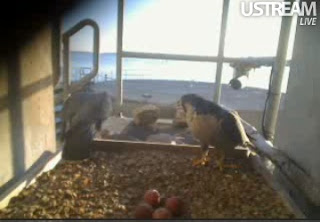This peregrine pair is very consistent. Two years in a row the female has produced her first egg on March 18th followed by three more eggs approximately 48 hours apart. This year the first arrived about 9:00 am. The second egg was laid about 3:00 pm on March 20th. The third and fourth eggs arrived in the early morningof March 23rd and March 25th.
Before each egg was laid, the female displayed typical egg laying behavior. She appeared to be somewhat agitated, laying down, standing up and laying down again as if trying to get comfortable. Peregrines, like all birds, can control each of their feathers and you rarely see them looking ruffled. Just before laying each egg, though, the female seemed to be sitting on her legs with her feathers puffed up.
As BRI Peregrinecam watchers have observed, the peregrines do not begin incubating the eggs consistently until the penultimate or last egg is laid. Last year many cam watchers were concerned that the eggs were left uncovered for long periods of time. I checked the weather for this week in 2010 found that temperatures during that week ranged from highs over 50 degrees to lows of 40 degrees. Perhaps last year’s warm temperatures explain why the adults did not spend long periods incubating the eggs until the last one was laid. This year the adults seem to be doing a fine job of protecting the eggs from this year’s cool temperatures (highs have been in the 40s with lows in the teens). Interestingly, early on in development eggs are relatively cold hardy and can withstand periods of exposure depending on the outdoor temperature. Later in the season as the embryo develops hot temperatures can pose a problem for embryo survival. One possible benefit of this peregrine pair's scrape location is that is well-protected from mid-day sun.
Now the wait begins. The eggs should hatch the week of April 27 (approximately 34 days after the last egg was laid). Let’s hope for another successful season for these wonderful birds.
Thanks for joining in the conversation and enjoying the BRI Peregrinecam. To keep up with daily activities please visit us in our online community by clicking here.
Happy falcon watching,
Kate Rotroff
BRI Peregrinecam Ambassador


